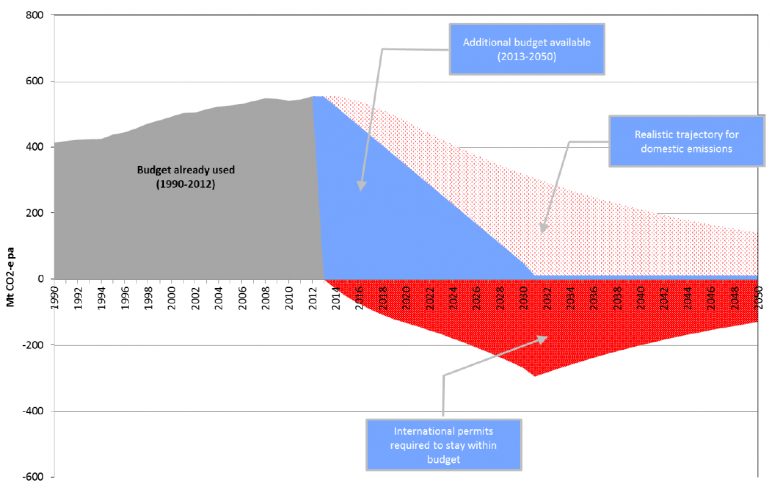11 years left on Australia's carbon budget
The World Wildlife Fund, or WWF, yesterday released analysis suggesting that if the world were serious about limiting global warming to 2 degrees, Australia would consume its remaining allowable budget for carbon emissions within 11 years.
For those unfamiliar with the concept, the global carbon budget is an attempt to quantify the cumulative amount of greenhouse gases the world’s people could emit if we wanted to have a reasonable probability of keeping temperature rise to a particular level.
So if we wanted a 50-50 chance of keeping global average temperature rise below 2 degrees, the world would need to keep to a carbon emissions budget of 840 gigatonnes of carbon (to convert to carbon dioxide equivalent multiply by 3.67). If we wanted, say, a two-thirds chance of keeping the rise below 2 degrees then the world would need to keep to a budget of 800 gigatonnes. Now, the problem is that we’ve already used up 531 gigatonnes of the budget due to emissions released in the past.
These carbon budget numbers were detailed in the latest Intergovernmental Panel on Climate Change assessment report. WWF then asked the climate change analysis firm, Ecofys, to work out how this global budget translates into a budget for Australia.
At present, Australia’s per person emissions are many times those of the average person around the globe – and even double those of a Frenchman. Most people would agree that it’s not really fair that Australians be allowed to emit vastly more than, say, an impoverished African or Indian, or even a very energy-efficient Japanese person or a very carbon conscious German.
So Ecofys divided up the global carbon budget to nations, assuming Australia’s per person emissions would need to converge over time with those of other people around the world under both the ‘contraction and convergence’ and the ‘common but differentiated convergence’ scenarios. The table below outlines their results.
It also details a third scenario, ‘greenhouse development rights’, where the budget was allocated taking into account the idea that the rich nations have greater capacity to afford emission reduction technology and given their higher historical emissions have greater responsibility to solve the problem.
The table shows that Australia really needs to get cracking in reducing its emissions if it's to do its fair share of keeping temperature rise below 2 degrees.
Budget allocated, used and remaining for Australia (excluding land use change and forestry)

Source: Ecofys analysis
Translating this into annual emissions reduction targets in the table below, the analysis suggests Australia would need to drastically up the level of ambition for its 2020 emission target from the 5 per cent cut which both Labor and the Coalition seem reluctant to tighten.

Source: Ecofys analysis
The kind of emission cuts outlined by Ecofys, if they were to be undertaken solely through action in Australia, are politically inconceivable. The Coalition’s current financial budget allocation to its emissions reduction fund even suggests it isn't likely to deliver on the bare minimum 5 per cent reduction.
WWF has recognised this political reality and provides an alternative, less radical path for Australia to play its fair part.
The chart below outlines in light blue our remaining allowable annual emissions if we were to keep to the carbon budget. It won’t happen.
So WWF provides an alternative “realistic trajectory” (in light red shading) where we reduce domestic emissions by a still rapid 4 per cent per annum. But in addition, Australia makes up for overshooting its own budget by funding low-cost emissions reduction activities overseas (illustrated in darker red).
Australia's annual emissions trajectory to keep to budget through domestic abatement alone or "realistic" trajectory involving international carbon credits

Source: Ecofys analysis
















